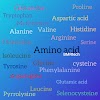Glutamic Acid | History | Structure | Function....
GLUTAMIC ACID
Glutamic acid (symbol Glu or E) is an α-amino acid that is used by almost all living beings in the biosynthesis of proteins.
Or
L-glutamic acid is an optically active form of glutamic acid having L-configuration.
It has a role as a nutraceutical, a micronutrient, an Escherichia coli metabolite, a mouse metabolite and a neurotransmitter. It is a glutamine family amino acid, a proteinogenic amino acid, a glutamic acid and a L-alpha-amino acid. It is a conjugate acid of a L-glutamate(1-). It is an enantiomer of a D-glutamic acid. A non-essential amino acid naturally occurring in the L-form. Glutamic acid is the most common excitatory neurotransmitter in the CENTRAL NERVOUS SYSTEM. It serves as the precursor for the synthesis of the inhibitory gamma-aminobutyric acid (GABA) in GABA-ergic neurons. The glutamate neurotransmitter plays the principal role in neural activation. This anion is also responsible for the savory flavor (umami) of certain foods, and used in glutamate flavorings such as MSG.
Properties :-
Chemical formula :- C5H9NO4
Molar mass :- 147.130 g·mol−1
Appearance :- white crystalline powder
Density :- 1.4601 (20 °C)
Melting point :- 199 °C (390 °F; 472 K) decomposes
Thermodynamic data :- Phase behaviour (solid–liquid–gas)
STRUCTURE :-
HISTORY :-
 |
| Karl Heinrich Ritthausen |
The substance was discovered and identified in the year 1866, by the German chemist Karl Heinrich Ritthausen who treated wheat gluten (for which it was named) with sulfuric acid. In 1908 Japanese researcher Kikunae Ikeda of the Tokyo Imperial University identified brown crystals left behind after the evaporation of a large amount of kombu broth as glutamic acid. These crystals, when tasted, reproduced the ineffable but undeniable flavor he detected in many foods, most especially in seaweed. Professor Ikeda termed this flavor umami. He then patented a method of mass-producing a crystalline salt of glutamic acid, monosodium glutamate.
SYNTHESIS :-
Biosynthesis :- Biosynthesis is a multi-step, enzyme-catalyzed process where substrates are converted into more complex products in living organisms. In biosynthesis, simple compounds are modified, converted into other compounds, or joined together to form macromolecules. This process often consists of metabolic pathways. Some of these biosynthetic pathways are located within a single cellular organelle, while others involve enzymes that are located within multiple cellular organelles. Examples of these biosynthetic pathways include the production of lipid membrane components and nucleotides. Biosynthesis is usually synonymous with anabolism.
The prerequisite elements for biosynthesis include: precursor compounds, chemical energy (e.g. ATP), and catalytic enzymes which may require coenzymes (e.g.NADH, NADPH). These elements create monomers, the building blocks for macromolecules. Some important biological macromolecules include: proteins, which are composed of amino acid monomers joined via peptide bonds, and DNA molecules, which are composed of nucleotides joined via phosphodiester bonds.
Industrial synthesis :- Glutamic acid is produced on the largest scale of any amino acid, with an estimated annual production of about 1.5 million tons in 2006. Chemical synthesis was supplanted by the aerobic fermentation of sugars and ammonia in the 1950s, with the organism Corynebacterium glutamicum (also known as Brevibacterium flavum) being the most widely used for production. Isolation and purification can be achieved by concentration and crystallization; it is also widely available as its hydrochloride salt.







0 Comments